NCR+ ILC3 Cell Markers
Click on one of the ILC subsets shown in the buttons below to see the markers that are commonly used to identify each cell type.

CD1a-
CD3-
CD11c-
CD14-
CD19-
CD34-
CD94-
DLEC/CLEC4C/BDCA-2-
Fc gamma RIII/CD16-
Fc epsilon RI-
IL-3 R alpha/CD123-
TCR alpha/beta-
TCR gamma/delta-
MOUSE
CD3-
CD19-
B220/CD45 R-
CD5-
CD11b-
Gr-1/Ly6G-
Ter-119-
A note regarding Lin- Markers
Overview
Group 3 ILCs (ILC3s) are a subset of innate lymphoid cells (ILCs) that is required for host defense against specific extracellular bacteria and fungi. In contrast to the other ILC subsets, ILC3s require the transcription factor ROR gamma t for their development and function and they produce either IL-17 and IL-22, or IL-22 alone. As a result, ILC3s have been suggested to be the innate counterpart of Th17 or Th22 cells. ILC3s are activated by IL-23, IL-1 alpha, IL-1 beta, IL-7, TL1A, and prostaglandin E2 (PGE2), and like other ILCs, they lack rearranged antigen receptors. ILC3s have been most extensively studied in the intestinal mucosa and skin, and have been suggested to be involved in the pathogenesis of Crohn’s disease and psoriasis. Two subsets of ILC3s have been characterized in both mice and humans, which are known as either natural cytotoxicity receptor positive (NCR+) ILC3s or NCR negative (NCR-) ILC3s. In mice, CCR6 and NKp46 are commonly used to distinguish these two subsets. (NCR+) ILC3s (also known as NK-22 cells) have been described as Lin-CCR6-NKp46+CD90/Thy1+CD117/c-kit+CD127/IL-7 R alpha+ cells, while (NCR-) ILC3s are Lin-CCR6+NKp46-CD90/Thy1+CD117/c-kit+CD127/IL-7 R alpha+ cells. Both ILC3 subsets produce IL-22, but unlike (NCR-) ILC3s, most (NCR+) ILC3s also express T-bet and produce IFN-gamma. In humans, two subsets of CCR6+CD117/c-kit+CD127/IL-7 R alpha+ ILC3s have been characterized based on the differential expression of NKp44. (NCR+) ILC3s express NKp44, while (NCR-) ILC3s lack expression of this marker. In addition, most human (NCR+) ILC3s express NKp46 and NCAM-1/CD56 and are a primary source of IL-22, but unlike mouse (NCR+) ILC3s, they do not express T-bet or IFN-gamma.
Data Examples
Detection of Cell Surface Markers on ILCs from Mouse Peyer’s Patches by Flow Cytometry. (A) Single cell suspensions were obtained from mouse Peyer’s patches and stained with a mouse lineage marker cocktail containing Alexa Fluor®700-conjugated monoclonal antibodies against CD3, B220, Ter-119, CD11b/Integrin alpha M, Gr-1, and CD5 (R&D Systems, Catalog # FLC001N). Lineage negative cells (CD3-, B220-, Ter-119-, CD11b/Integrin alpha M-, Gr-1-, and CD5-) were gated on by flow cytometry. (B) CD117+ CD127+ ILCs in the lineage negative population were detected by staining with an APC-conjugated Rat Anti-Mouse CD117/c-kit Monoclonal Antibody (R&D Systems, Catalog # FAB1356A) and an Alexa Fluor®488-conjugated Rat Anti-Mouse CD127/IL-7 R alpha Monoclonal Antibody (R&D Systems, Catalog # FAB47742G). (C) NKp46 and CD25/IL-2 R alpha were detected on Lin- CD117+ CD127+ ILCs by staining with a PE-conjugated Rat Anti-Mouse NKp46/NCR1 Monoclonal Antibody (R&D Systems, Catalog # FAB22252P) and a PerCP-conjugated Rat Anti-Mouse CD25/IL-2 R alpha Monoclonal Antibody (R&D Systems, Catalog # FAB2438C).

